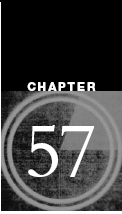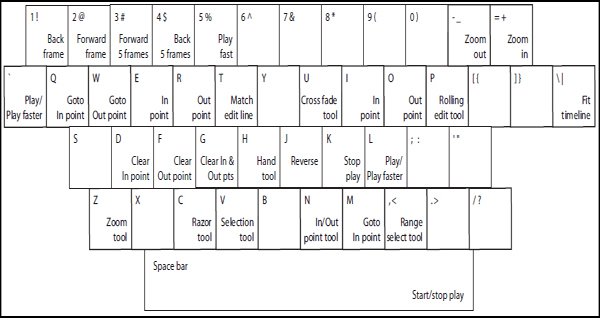Shortcut Keys
Applications
If you’re editing a lot of footage in Final Cut Pro or Adobe Premiere, you’ll need to learn the keyboard shortcuts to use it most efficiently. Professional editors have special keyboards with all the important editing commands written directly on the keys. Film editors sometimes almost look like typists the way they tap the keyboard to activate sequences of commands.
If you want to maximize the time you spend in editing, you’ll need to learn as many of these commands as you can. To help you overcome the substantial learning curve, it can be incredibly useful to have these shortcuts affixed directly to the appropriate keys. This chapter provides templates for the most common shortcuts in Final Cut Pro and Adobe Premiere. You can copy or print a template onto an adhesive-backed sheet of paper. Once the sheet is printed, individual labels can be cut out with a scissors and attached to the proper keys. While these labels won’t last forever, they should be useful long enough for you to learn all the individual commands.
PARTS
| Qty | Item |
| 2 | Sheets of adhesive copier or printer paper |
General Instructions
There are literally dozens of shortcut keys for any application. Editing programs are different from other programs since many of the important shortcuts don’t require key modifiers such as the Option, Ctrl, Shift, Command, or Alt keys. The labels included in these templates only show the single-key activation commands since including the modifier-based functions will make things cluttered and difficult to read. For a complete list of modifier keys, check the manual of your editing program.
The following templates are made for general key sizes. However, since there’s no actual standard among full-sized keyboards (let alone for portable keyboards), you may need to enlarge or reduce the template size to match your keys. Laptop keys are often 89% of their full-sized cousins.
If you have a scanner, you can easily scan the template into the computer and reduce or enlarge it to exactly the size you need. Otherwise, you’ll need to use trial and error with a copier that has reduction and enlargement capabilities.
Construction
The labels have been designed to fully cover each key, so they include the letter or symbol of the key in the upper-left corner. The shortcut is shown in the lower-right corner of the key. I’ve found these font sizes to be about the smallest size that is easily readable. Because of the size limitations, I’ve abbreviated some of the words in the shortcut description.
Final Cut Pro shortcuts
figure 57-1 contains the template for the Final Cut Pro keyboard. Keys without shortcut commands have been included for completeness, but the bottom-right corner has been left blank. The function key commands have been included at the top of the figure.
Premiere shortcuts
figure 57-2 contains the template for the Adobe Premiere keyboard. Keys without shortcut commands have been included for completeness, but the bottom-right corner has been left blank.
Suggestions
Here are a few operating suggestions to help you:
• Buy a cheap keyboard Keyboards have become staggeringly inexpensive at computer stores, so you might consider buying one strictly for use when editing. After placing the labels on the keys, you can attach it to the computer only when you need to edit. That will maximize the lifetime of the labels and leave your main keyboard pristine.
• Use the labels as a learning device When a label wears out, don’t replace it. Remove the remnants of the sticker from the key and then use it normally. This will help you learn the most common keys by heart. It will also assist you when you edit on a keyboard without the labeled shortcuts.
FIGURE 57.1 A template for the shortcut commands of a Final Cut Pro keyboard.
FIGURE 57.2 A template for the shortcut commands of an Adobe Premiere keyboard.



